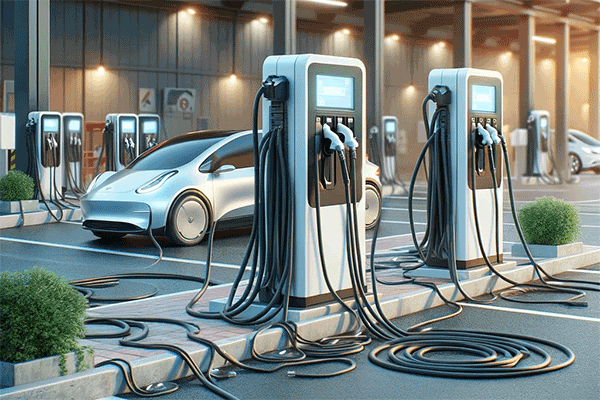In an era where technology pervades every aspect of our lives, the way we manage and maintain our power sources has become crucial. This is particularly evident in the realm of charging depots, where effective cable management is not just a matter of organization, but a critical component of operational efficiency and safety.

Current Trends in Charging Infrastructure and Technology Advancements
Today’s charging depots are characterized by advanced technologies that include smart charging systems, wireless charging, and automated cable management solutions. The trend towards green energy and sustainable practices has also influenced the design and operation of charging stations, with a focus on minimizing energy loss and optimizing space utilization. Innovations in cable management are now integral to the charging depot infrastructure, ensuring that cables are not only well-organized but also protected from environmental factors and wear and tear.
Safety Considerations
Inadequate cable management can lead to a myriad of safety risks. Loose cables can result in tripping hazards, increasing the likelihood of injuries to users. Exposed cables are susceptible to environmental damage, wear and tear, and vandalism, which can cause electrical shorts and fire hazards. These risks are especially pronounced in outdoor charging depots, where environmental exposure is a significant concern.
Efficiency and Reliability
Contribution of Cable Management to Charging Depot Efficiency
Proper cable management is essential for the smooth operation of charging depots. By ensuring that cables are neatly organized and easily accessible, charging depots can service more vehicles efficiently, reducing wait times and enhancing user experience.
Well-managed cables also prevent damage and wear, leading to less downtime for repairs and maintenance, thereby increasing the overall reliability of the charging stations.
Impact on Equipment Lifespan and Maintenance
Proper cable management significantly extends the lifespan of charging equipment. Cables that are well-protected and organized are less likely to suffer from environmental damage, physical stress, or vandalism.
Regular maintenance is easier and more effective when cables are well-organized, leading to quicker identification and resolution of potential issues, ultimately reducing long-term maintenance costs.
Benefits for Users
For users, efficient cable management translates to a more reliable and user-friendly charging experience. With cables neatly organized and safely managed, users can easily connect their vehicles, ensuring a smooth and hassle-free charging process.
Improved reliability and reduced downtime at charging depots also mean that users can depend on these facilities for their charging needs, fostering greater confidence in and adoption of electric vehicles.
Aesthetic and Environmental Impact
Influence on Visual Appeal of Charging Depots
Effective cable management significantly enhances the aesthetic appeal of charging depots. Neat and orderly cable setups create a more professional and welcoming environment, positively impacting public perception and encouraging the use of these facilities.
Visual appeal is especially important in urban and residential areas, where charging stations are part of the community landscape. A well-maintained depot can blend seamlessly into its surroundings, promoting wider acceptance and integration of electric vehicles.
Environmental Considerations
Cable management also plays a role in environmental sustainability. By protecting cables from damage and extending their lifespan, it reduces the need for frequent replacements, thereby cutting down on electronic waste.
Efficient cable management can lead to more energy-efficient charging processes, as well-maintained cables and connections ensure optimal power transfer and reduced energy loss.
Contribution to Public Perception and Acceptance
The state of charging depots, including how cables are managed, directly affects public perception of electric vehicle infrastructure. Well-organized and aesthetically pleasing charging stations can boost confidence in and the appeal of EV technology.
By demonstrating attention to detail and commitment to environmental and aesthetic standards, charging depots with excellent cable management are more likely to be viewed as a positive and essential part of modern transportation infrastructure.
Future cable management solutions are expected to focus on even greater efficiency, user-friendliness, and environmental sustainability. Anticipated developments include more robust materials for cables, smarter cable allocation systems, and greater integration with renewable energy sources.














